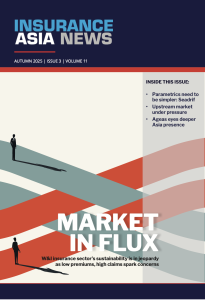Economic troubles, geopolitical instability, climate change major challenges for 2025 (re)insurance market
January 13 2025 by Joana Nguyen
The macroeconomic environment, geopolitical tensions and climate change will continue to be the key factors shaping the (re)insurance market in 2025, both globally and in Asia, market sources told InsuranceAsia News (IAN).
Howden, in its latest renewal report, Past the pricing peak, also said that the low growth outlook, structurally higher inflation, a shifting yield curve and rising geopolitical risk would have major implications for the (re)insurance market.
Amid China’s economic slowdown, the industry is concerned about the broader growth prospects in the region.
“I think the recovery of the global economy is the key issue in 2025,” said Wang Wei, chief executive of Hong Kong-based (re)insurance broker Rare Earth. “The situation for the year is still not optimistic, even for China, which used to be the engine that drove economic development. That impacts the industry significantly in various aspects such as pricing, capacity and market demand.”
Arthur Roiret, senior manager at consultancy Sia Partners, told IAN: “A decline in interest rates is expected across major Asian markets, with projections ranging from 0.2% in China to 1% in Indonesia, aligning with trends in the US and Europe. However, Japan may see rising rates. Persistent inflation, particularly in health and healthcare, continues to pressure insurance profitability, complicating financial stability for insurers.”
The outlook for the global economy in 2025 remains uncertain, according to Darren Pigg, partner, and APAC insurance lead and head of Hong Kong at consultancy Capco.
Inflation, which is expected to reduce from its previous highs in 2024, will be tempered by the instigation of Trumpnomics aimed at increasing economic activity through increased government spending and tax reforms, he said.
“When coupled with the threatened tariffs on many countries and the downward direction of inflation, there is a possibility that this trend could quickly reverse. I would suggest that the theme of greater uncertainty due to greater geopolitical tensions is definitely likely to persist into 2025,” Pigg said.
“Current macroeconomic conditions will continue to drive market sentiment and movement in 2025,” said Tan Hian Hong, operations senior vice president and operations manager for Asia at property insurer FM.

“Carriers are looking to introduce aggressive pricing strategies to boost their market share, especially in Asia where markets are less developed and have more room for growth.”
Hian Hong Tan, FM
Besides slow growth prospects, Bernhard Kotanko, senior partner at McKinsey, noted geopolitical tensions and volatile financial markets that are affecting the industry.
“Macro themes are indeed centred around geopolitical instability, capital markets, forex and interest rate volatility and overall challenge for Asian insurance businesses to deliver faster and higher free cash flows and profits for their shareholders, rather than mainly future growth and value creation promise,” he said.
From a market perspective, Greater China, Japan and South Korea have proven resilient, India shows growth but low profitability still, and South-East Asian markets need to overcome growth challenges, Kotanko added.
According to Anita Bong, EY’s APAC financial services insurance sector leader, while geopolitical tensions, changes in leadership in many countries, including the US, and interest rate fluctuations pose challenges, they also present opportunities for the insurance industry to create new products and attract new customers.
“Insurers must respond swiftly to these changes and seek growth opportunities by adapting to the evolving landscape,” she said.
Pricing and capacity
Regarding supply and demand, Tan and Kotanko agreed that the demand for insurance across the region would continue.
“Across Asia Pacific, the underlying need for insurance remains strong, also enabled by continued healthy savings ratios and a general affinity for protection and long-term wealth creation,” Kotanko said.
He noted that the market has “seen a continued “hard market” cycle for longer. And one could argue that this is not a cycle but actually a structural recalibration of pricing levels” to recognise the higher severity and frequency of nat cat events.
“That said, higher margins will attract more capital, especially also permanent private capital, and will then likely moderate the industry economics,” he added.

“Geopolitics is not going to go away. Will it really impact the insurance sector in Asia? Directly, probably not. But indirectly possibly, it has effects on interest rates and movements on financial markets, and in turn the valuation of assets and liabilities.”
Erik Bleekrode, KPMG
In the commercial property insurance market, growth is expected to stem from increased competition among carriers on the supply side and a demand-driven boost fuelled by heightened risk awareness from businesses, Tan said.
“Carriers are looking to introduce aggressive pricing strategies to boost their market share, especially in Asia where markets are less developed and have more room for growth,” Tan added.
“We are also noticing an increased broker activity in deals. While there are no significant newcomers to the market, brokers are becoming more involved in the process, leading to increased tender activity driven by competitive pricing.”
Regarding the outlook for retro capital, the industry expressed a degree of optimism about the insurance industry’s stability and potential for growth despite global economic uncertainties.
“The insurance industry is not charming but it is stable, in particular, for the current world economy,” said Wang of Rare Earth.
McKinsey’s Kotanko said: “We have seen overall an inflow of private permanent capital into insurance markets, especially in mature life insurance markets, and also via reinsurance constructs.”
“If reinsurers can effectively manage risks related to geopolitical tensions and natural disasters, we may see an increase in retro capital. Additionally, lower interest rates could enhance the attractiveness for investors,” according to Roiret of Sia Partners.
Geopolitics
Geopolitical tensions around the world are likely to continue, if not escalate.
“The geopolitical landscape may intensify with Donald Trump’s return to office in January 2025, particularly due to proposed import tariff increases—up to 60% on Chinese imports and 10-20% on imports from other Asian nations,” Roiret said.
“Such actions could trigger trade shocks for export-reliant economies, necessitating ongoing risk identification and mitigation strategies. This should have a direct impact on trade credit insurance which is still underdeveloped in Asia compared to regions like Europe and North America.”
Howden also noted in its report that geopolitics has played a dominant role in shaping the macro and loss environment in recent years, as a complicated new world order has raised the risk of conflict, political turbulence and civil unrest whilst also fuelling inflation.
These issues remained front and centre in 2024 as wars escalated and consequential political transitions followed the “biggest election year in history”.
The report also indicated a shift from outsized terrorism threats at the start of the century to war and military build-ups in more recent years, which correlates directly with supply chain security and inflation volatility.

“Macro themes are indeed centred around geopolitical instability, capital markets, forex and interest rate volatility and overall challenge for Asian insurance businesses to deliver faster and higher free cash flows and profits for their shareholders, rather than mainly future growth and value creation promise.”
Bernhard Kotanko, McKinsey
However, KPMG’s Erik Bleekrode, head of insurance, APAC region, shared a more moderate view on the impact of geopolitical tensions.
“Geopolitics is not going to go away. Will it really impact the insurance sector in Asia? Directly, probably not. But indirectly possibly, it has effects on interest rates and movements on financial markets, and in turn the valuation of assets and liabilities,” he said.
“Will it impact the business? Maybe a little bit, because it may impact trade flows around the world and insurance of those economic activities. But that’s not going to lead to material change.”
Climate challenge
Insurers are “getting more and more worried about man-made events and natural catastrophes,” KPMG’s Bleekrode told IAN.
“There have been more natural catastrophe events over the past years. This year is clearly not off to a good start with everything that is happening in California and that has a big impact on the non-life industry and the reinsurance industry because ultimately, they need to absorb those losses,” Bleekrode said.
Since January 7, two ongoing wind-fed fires have killed at least 16 people and swept through 37,000 acres in the greater Los Angeles area, destroying entire communities and more than 12,000 structures, including homes, outbuildings, sheds, mobile homes and cars.
The fire is moving east, threatening the exclusive neighbourhood of Brentwood, home to the Getty Center, a world-famous art museum that has now been evacuated.
In Asia, also on January 7, a 7.1 magnitude earthquake struck at a depth of 10km in Tingri county in the Tibet Autonomous Region of China, killing at least 126 people and destroying 3,600 buildings. Chinese insurers were reported to have so far paid compensation claims worth CNY453,000 (US$61,788).
According to Munich Re's recent nat cat report, natural disasters worldwide caused around US$140 billion in insured losses in 2024, a 32% increase from the previous year, making it the third most expensive year on record.
Economic losses were at US$320 billion compared to an inflation-adjusted US$268 billion in 2023, making last year fifth on the cost scale since 1980.
“They're just big and scary numbers and they'll only get bigger and bigger and scarier I think, so that's a really big theme and obviously that impacts Asia as well because we've got our typhoons, earthquakes, floods and volcanoes,” Bleekrode commented on the data of Munich Re.
“[Climate change] has an immediate impact on how insurers do their business, how they price their business, how they run their business. So they need to be very, very mindful of that.”
Bleekrode added that the acceleration of climate change creates a level of uncertainty where companies are less comfortable and less sure about what the price should be for the risk that they are assuming.
“I think one of the big struggles of the reinsurers is that everything seems to be happening everywhere all at once, and that does translate into how they need to think about pricing their products,” he said.

“Beyond the rate adjustment strategy to counterbalance rising losses, partnerships between reinsurers, insurers and academic institutions will be vital for accessing precise data and developing advanced predictive models.”
Arthur Roiret, Sia Partners
Munich Re’s chief climate scientist Tobias Grimm told IAN last week that the industry needs to be prepared for events in atypical regions and draw attention to increase efforts on loss prevention measures as “climate change does not spare anyone" and "these kinds of events can happen nearly everywhere."
However, making insurance more expensive cannot be a sustainable practice and could ultimately create a societal risk for ordinary people if insurance becomes unaffordable.
"Beyond the rate adjustment strategy to counterbalance rising losses, partnerships between reinsurers, insurers and academic institutions will be vital for accessing precise data and developing advanced predictive models," said Roiret of Sia Partners.
"This collaboration will improve risk assessment and underwriting practices, leading to more effective risk management solutions," he added, citing the collaboration between the Swiss Re Institute and Axa Research Fund, which aims to deepen understanding of systemic risks from extreme weather events, as an example of private-public partnership.
In addition, Roiret expected the emerging shift towards sustainable investments to continue, with reinsurers committing to net-zero carbon emissions in their portfolios and divesting from fossil fuels to align with global sustainability goals.
Pigg from Capco also supported sustainability and green insurance.
"ESG is becoming a much more prevalent boardroom topic globally, and it is no different for insurers in Asia. Target setting, reporting and action plans will continue to gain momentum as regulators also further their thinking in this space for the insurance domain," he said.
-
‘Humming’ India to be priority for insurers in 2026 amid market reforms, GDP growth
- December 16
Move to allow 100% foreign ownership of insurance companies, and rapid economic growth, will drive a wave of dealmaking.
-
P&I clubs all at sea ahead of renewals as they seek to navigate new claims normal
- December 8
International Group of P&I Clubs are eyeing premium increases ranging from 4-8% in February's renewals.
-
Exclusive: Hong Kong housing estate fire property claim could top US$200m, with China Taiping the sole insurer
- November 28
Hong Kong firm provides the master property insurance for the Wang Fuk Court housing estate, as well as contractors’ all-risk policy, including third-party liability, and employee compensation cover.
-
Tighter solvency regimes, market disruptions driving Asian demand for structured solutions: Swiss Re’s Kaspar Mueller
- November 27
Capital motivation, volatility protection and leveraging capital for growth are key motivations for cedent's seeking structured programs, the reinsuer's CUO for structured solutions says.
-
QBE | Elevating customer experience, humanising claims: QBE Asia’s ‘Solutions in a Box’
Vastly improving turnaround times and personalising service delivery, QBE Asia’s award-winning, end-to-end bundled claims solutions is a game-changer for the insurance industry.
-
Beazley | What does cyber protection look like from day 1 to day 600 and beyond?
Cybersecurity is no longer just an IT concern, but a governance issue that belongs on the boardroom agenda.
-
Sedgwick | Preparing for the next storm
Insurance industry needs to recalibrate, invest in innovation and strengthen systems, talent and data practices.
-
Peak Re | From climate modelling to market opportunity: Forging a new clarity on Southeast Asia’s climate risk
Southeast Asia's protection gap: a crisis of clarity, not just capital

